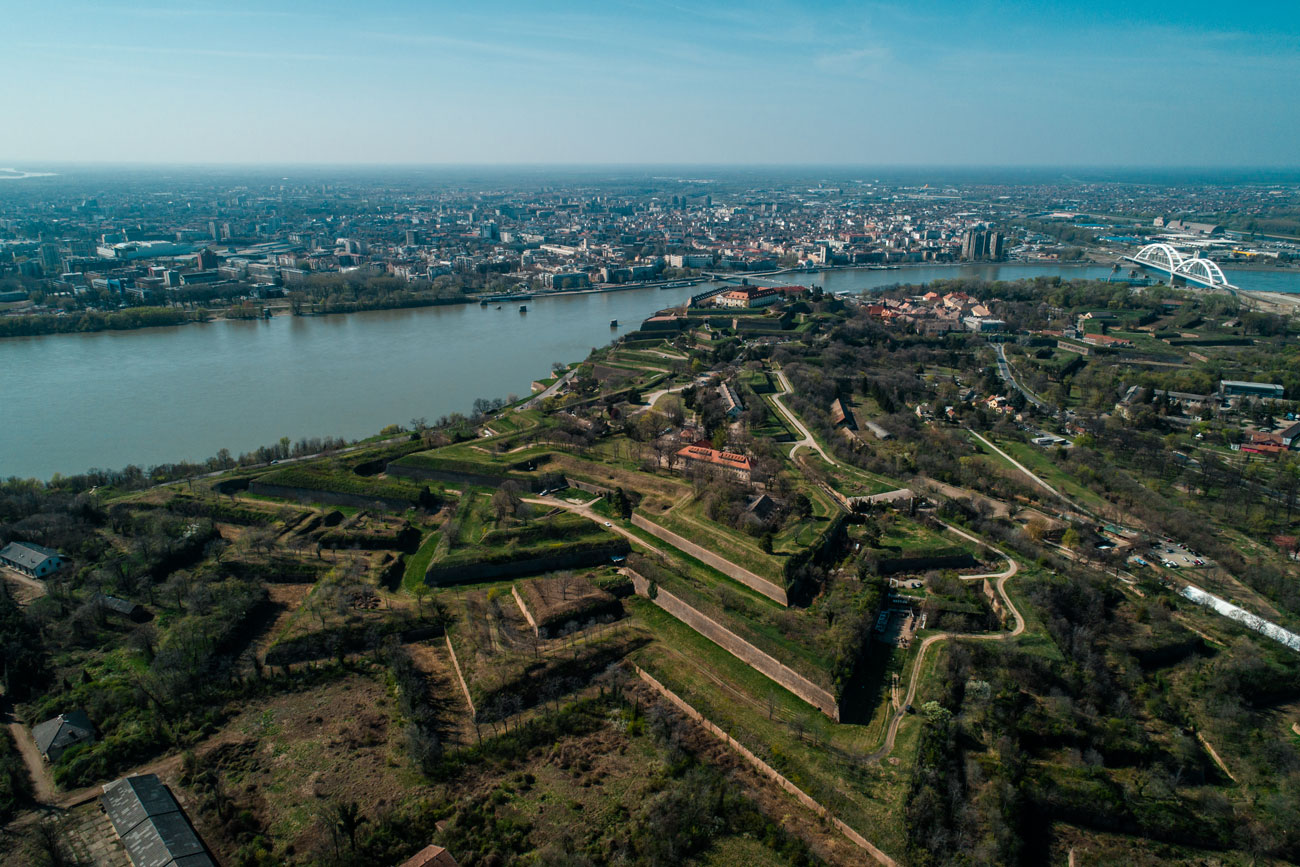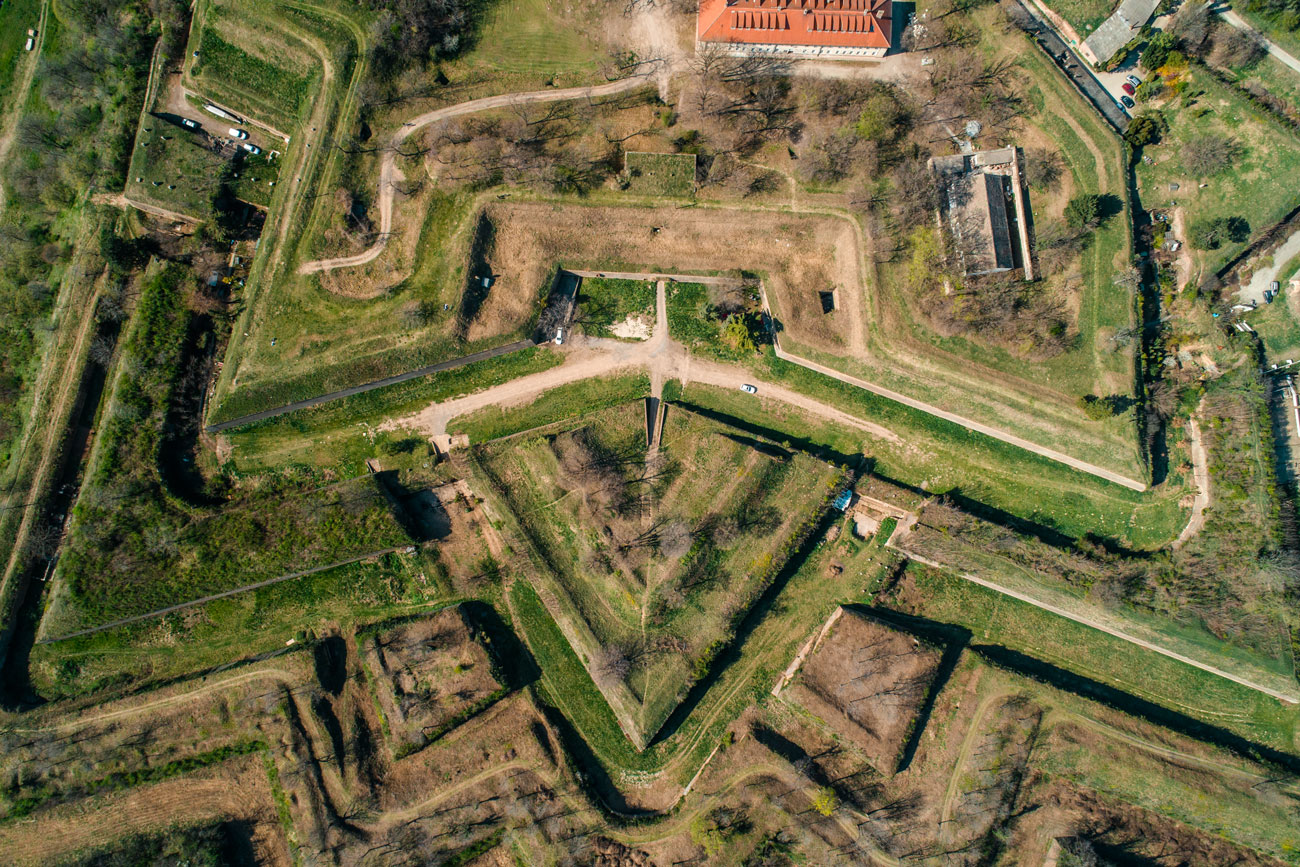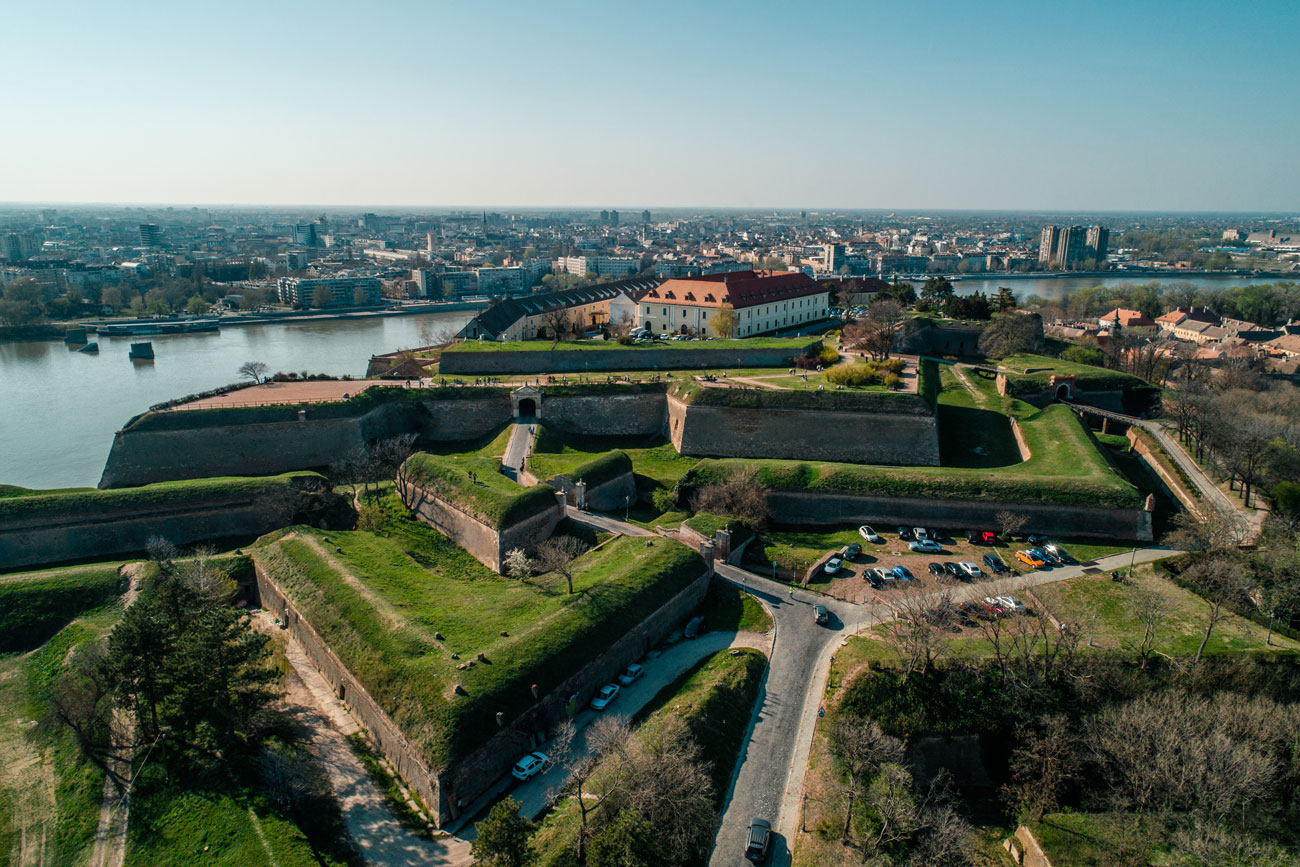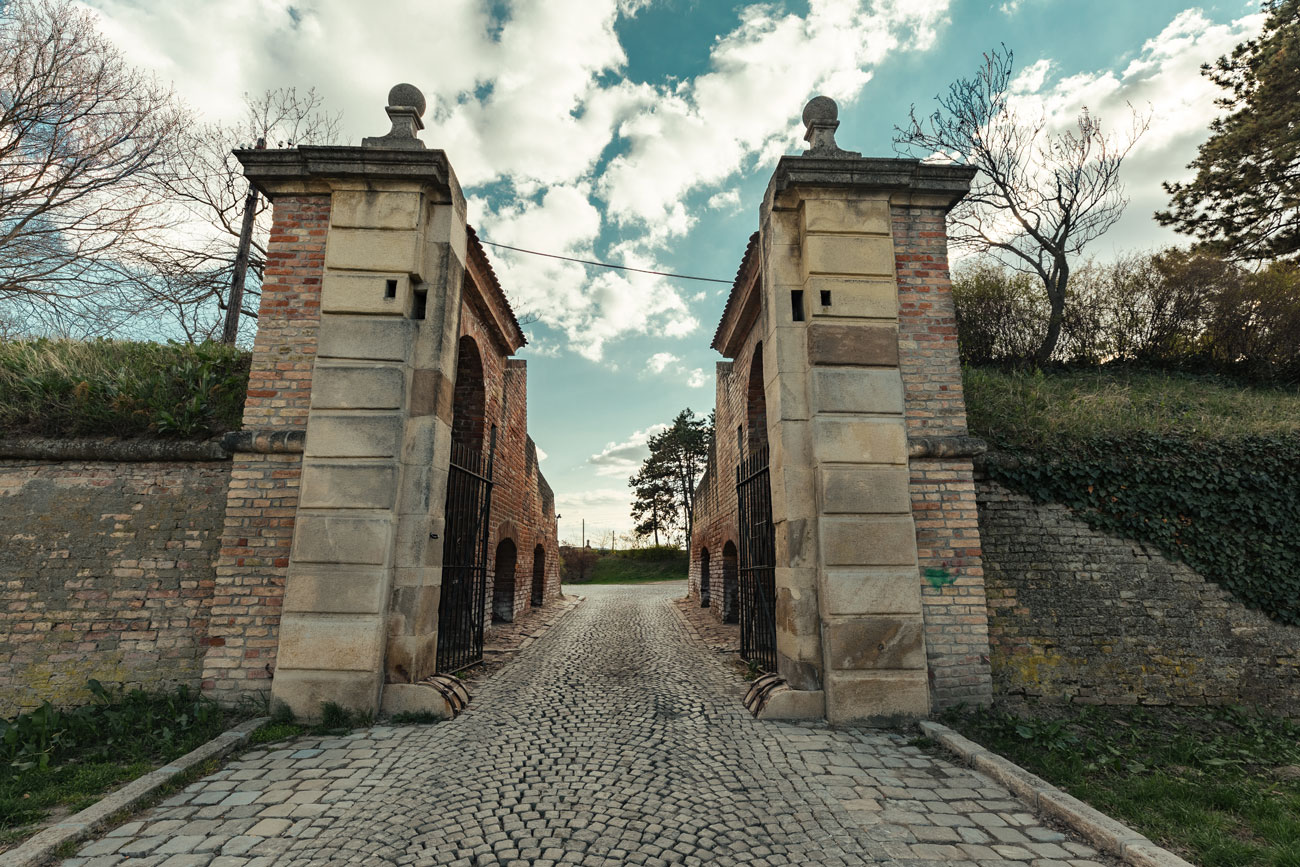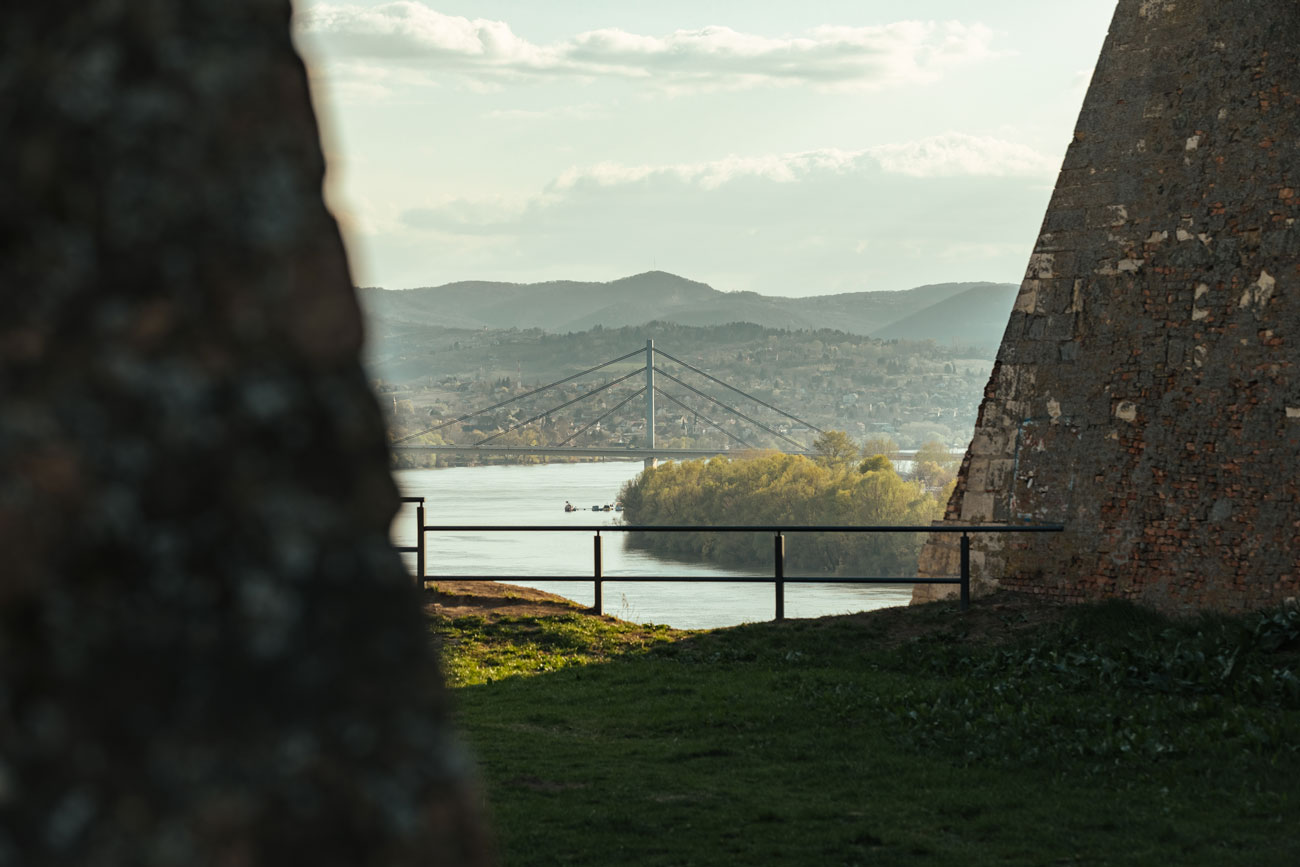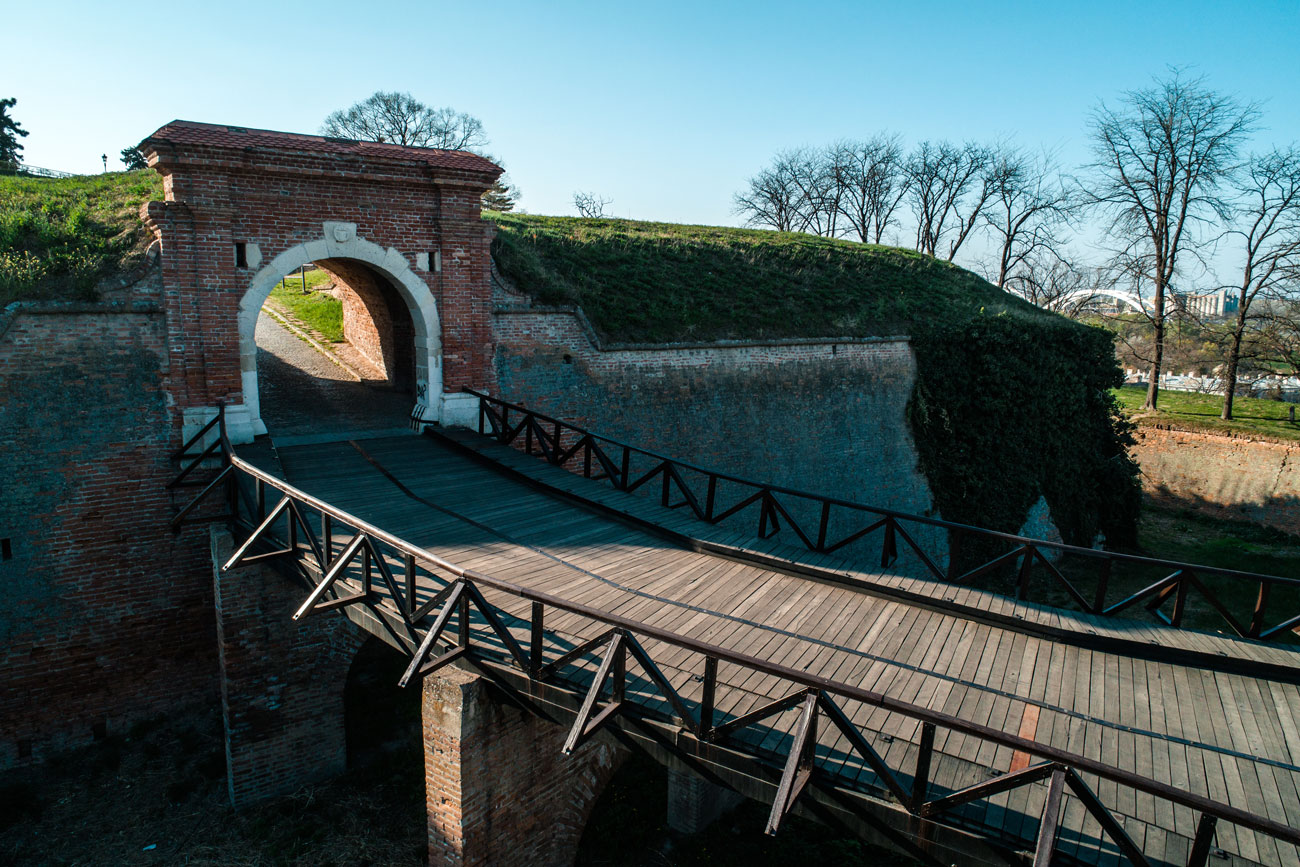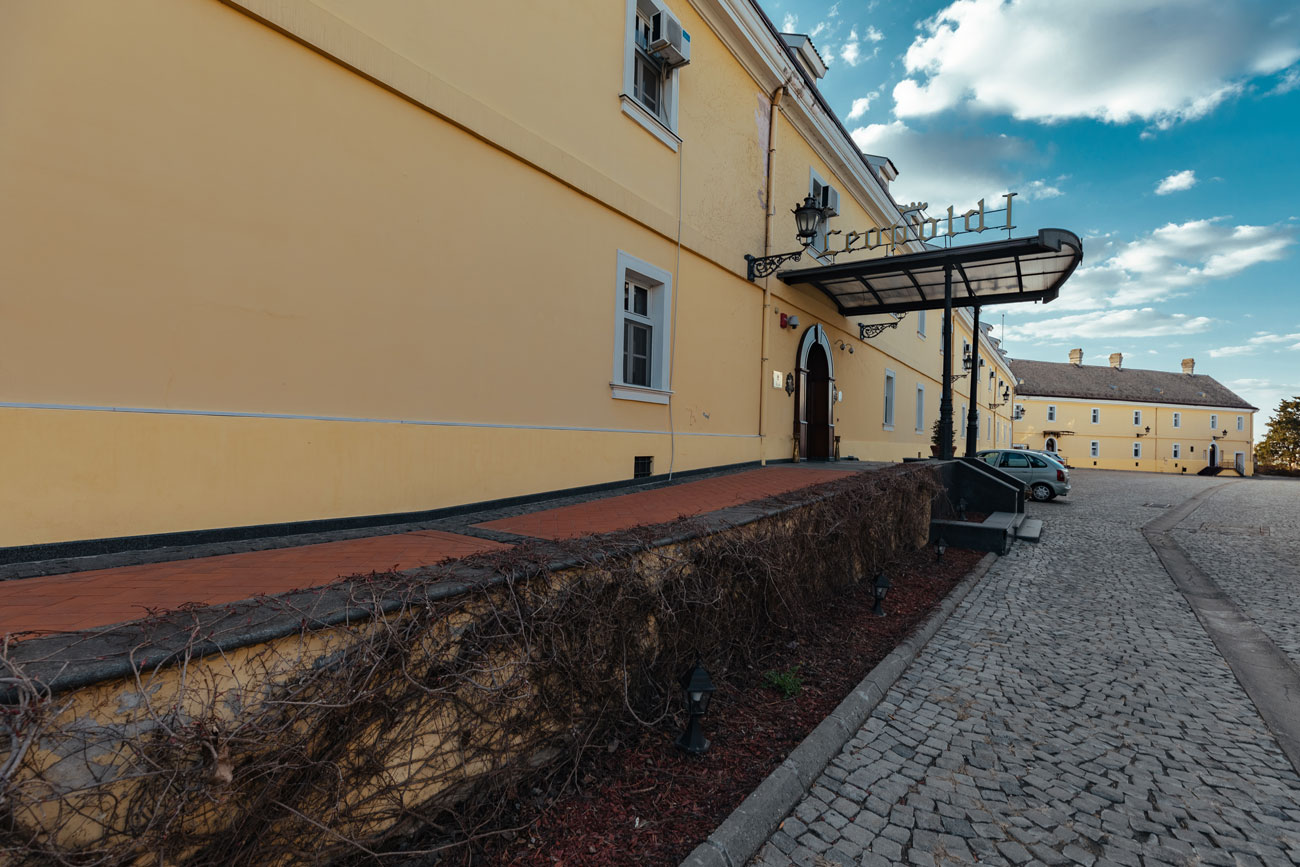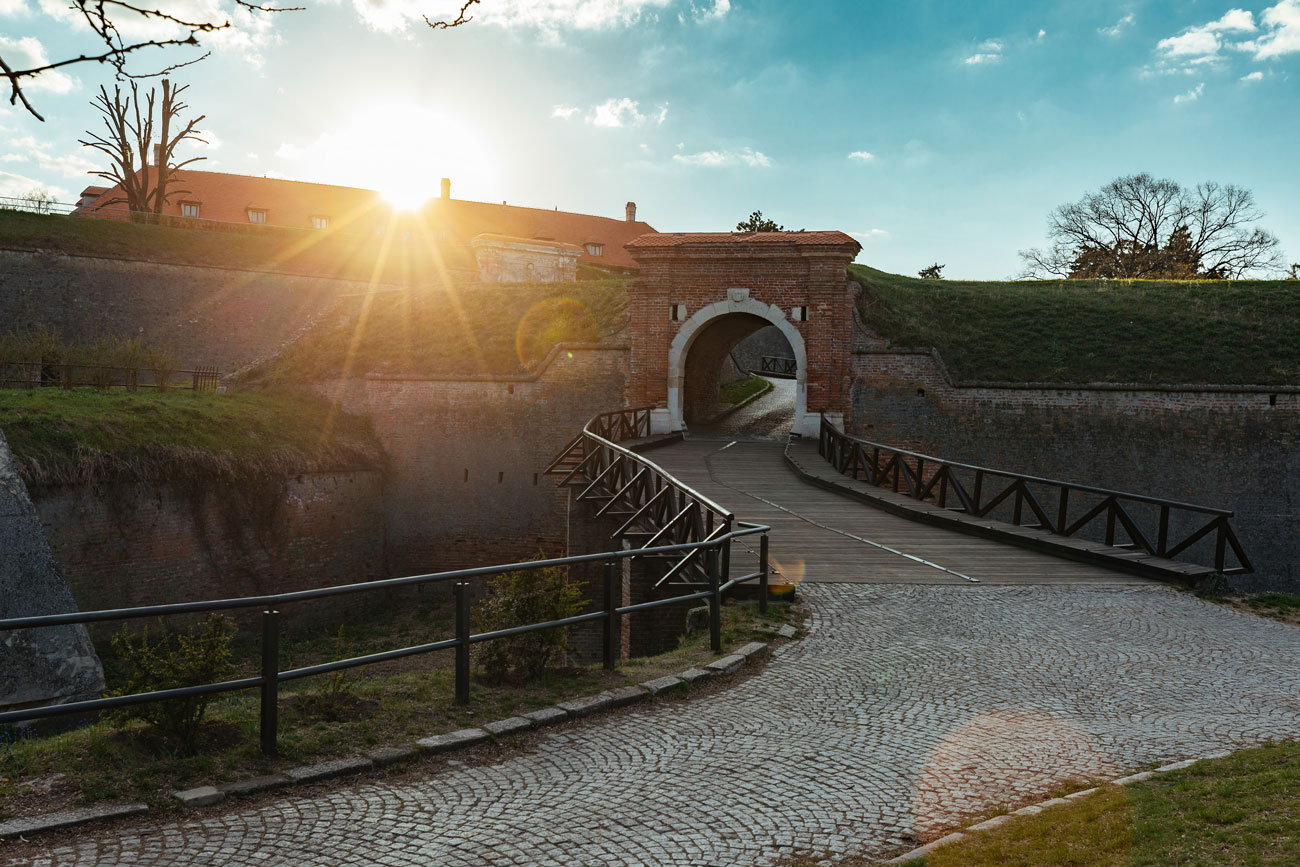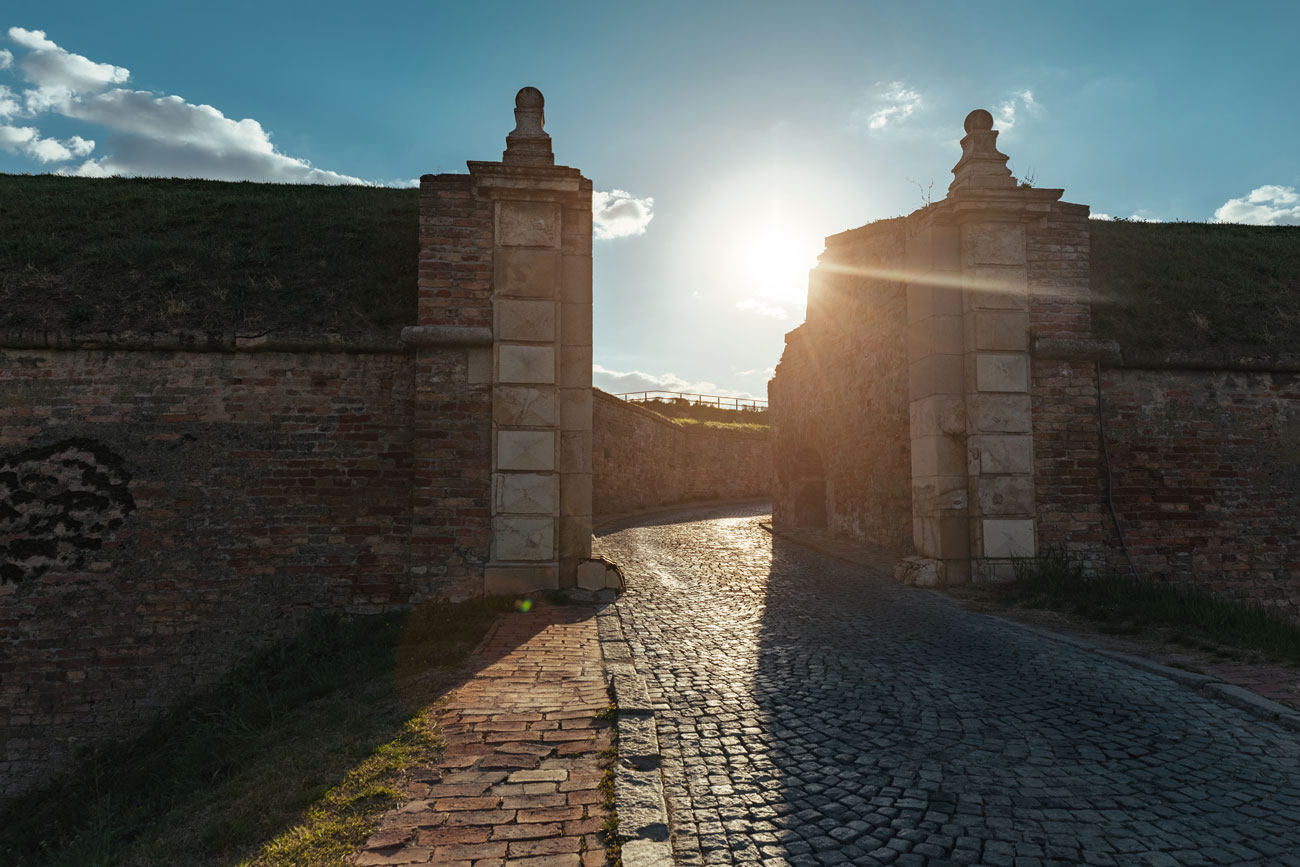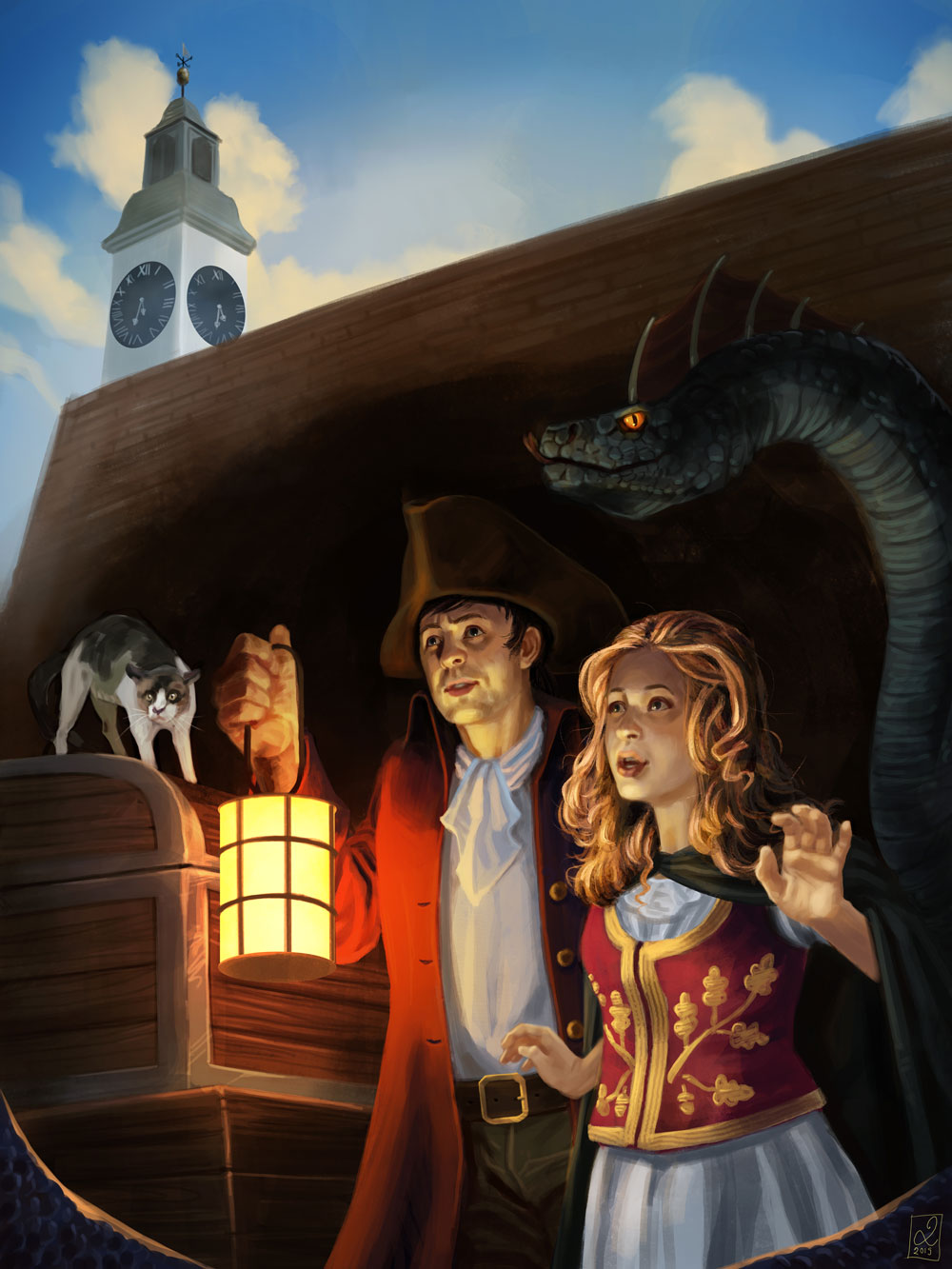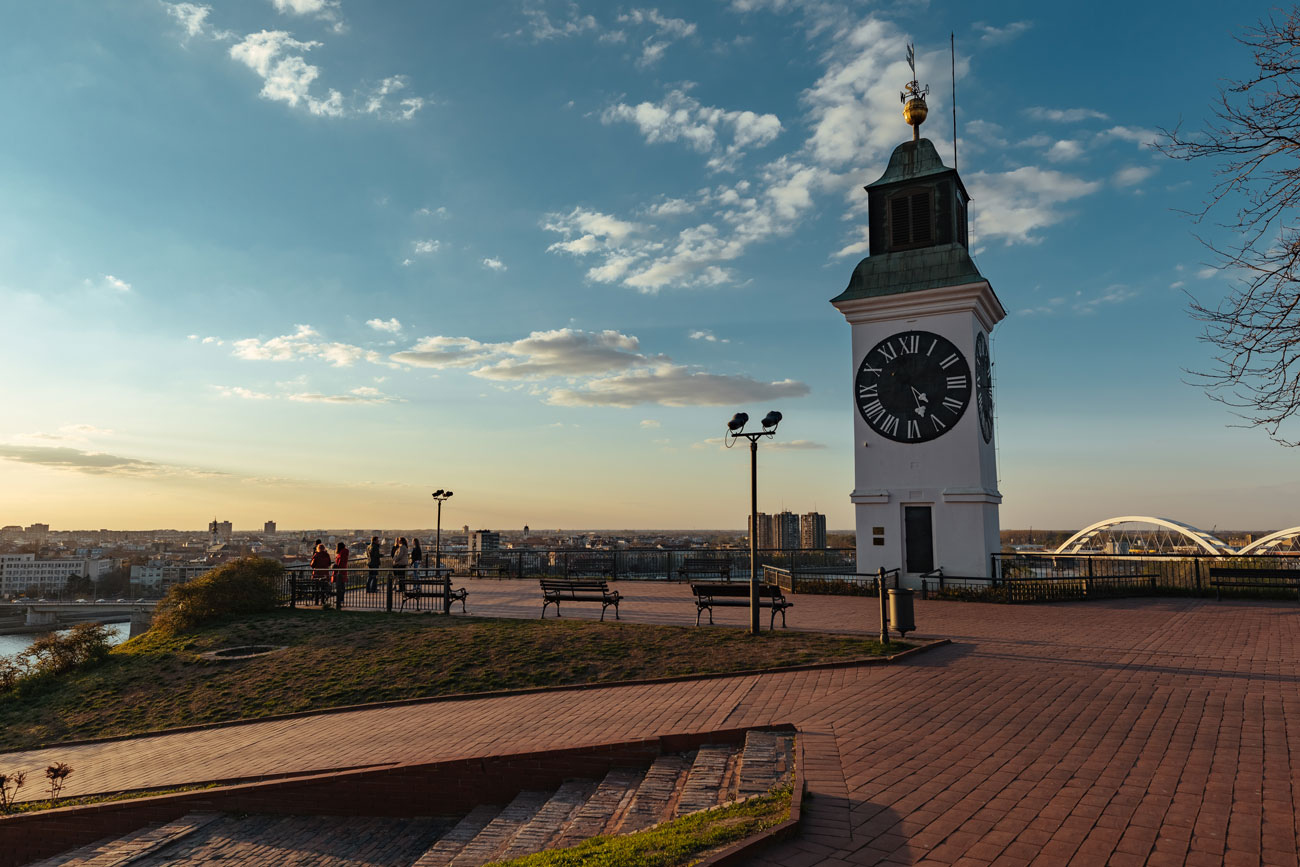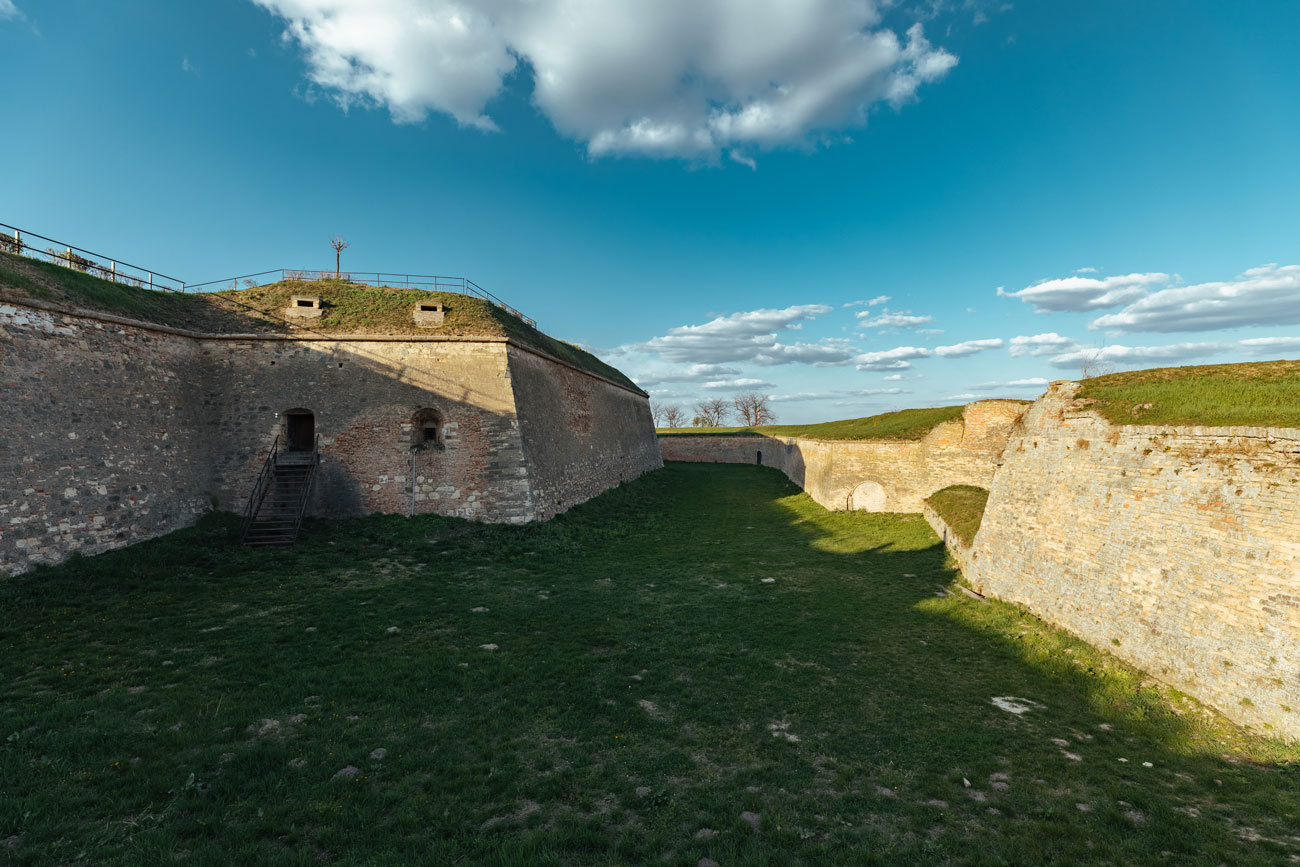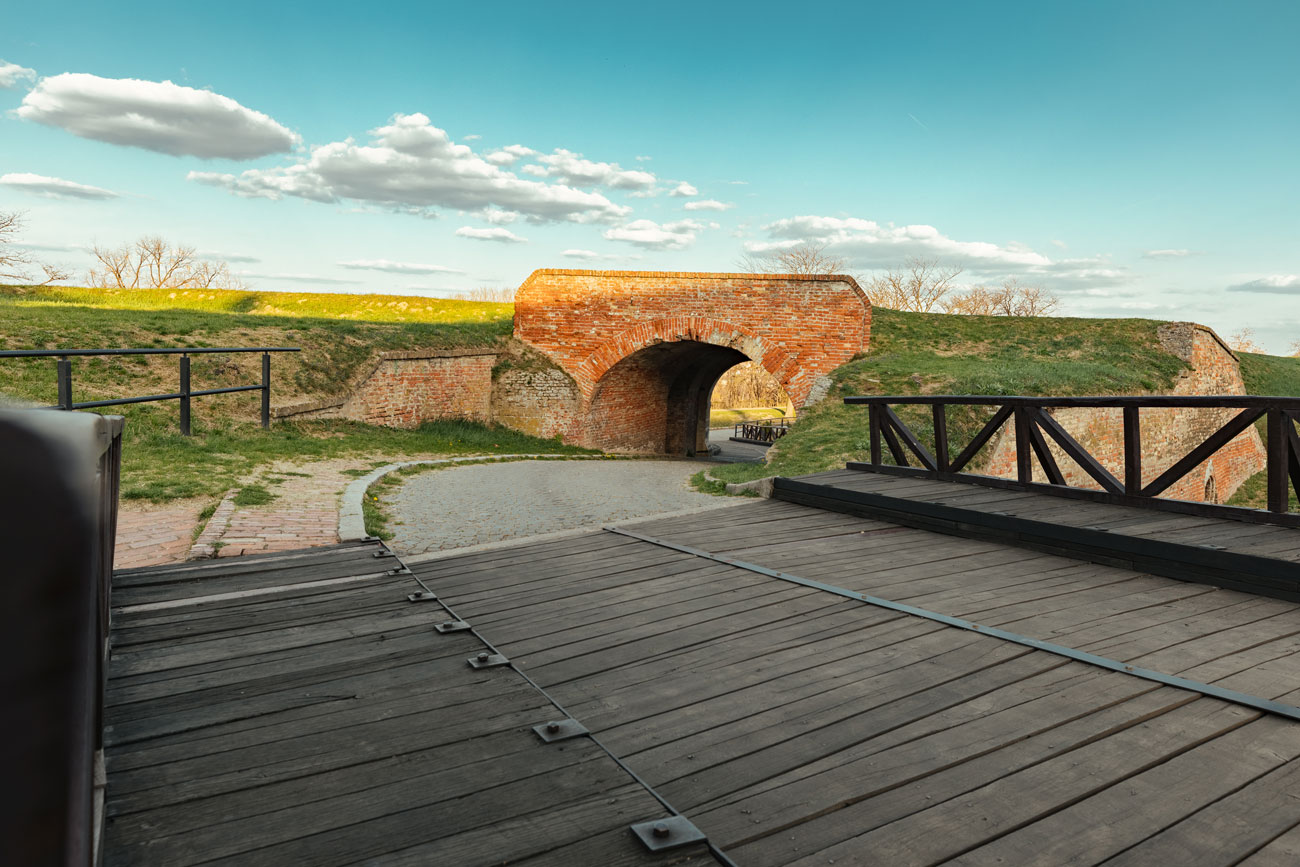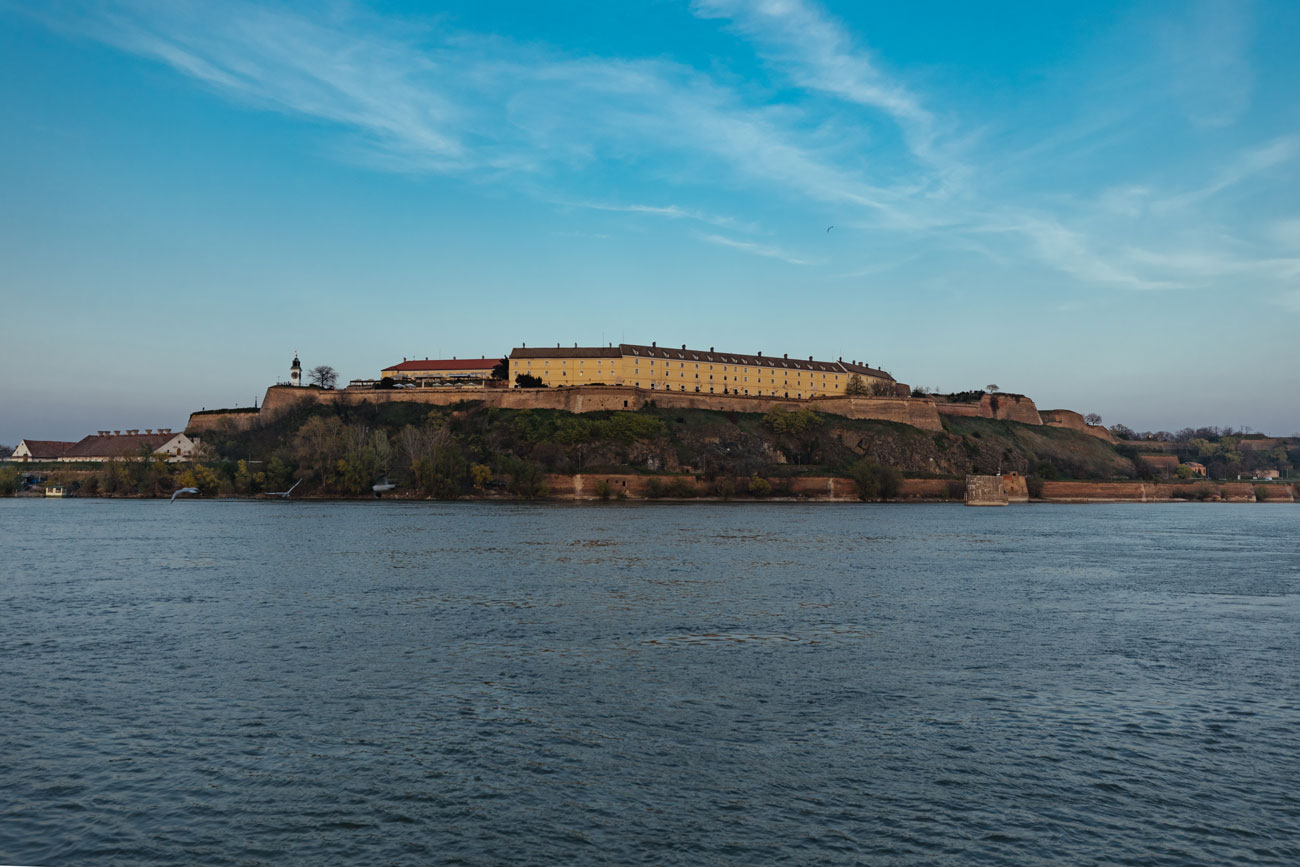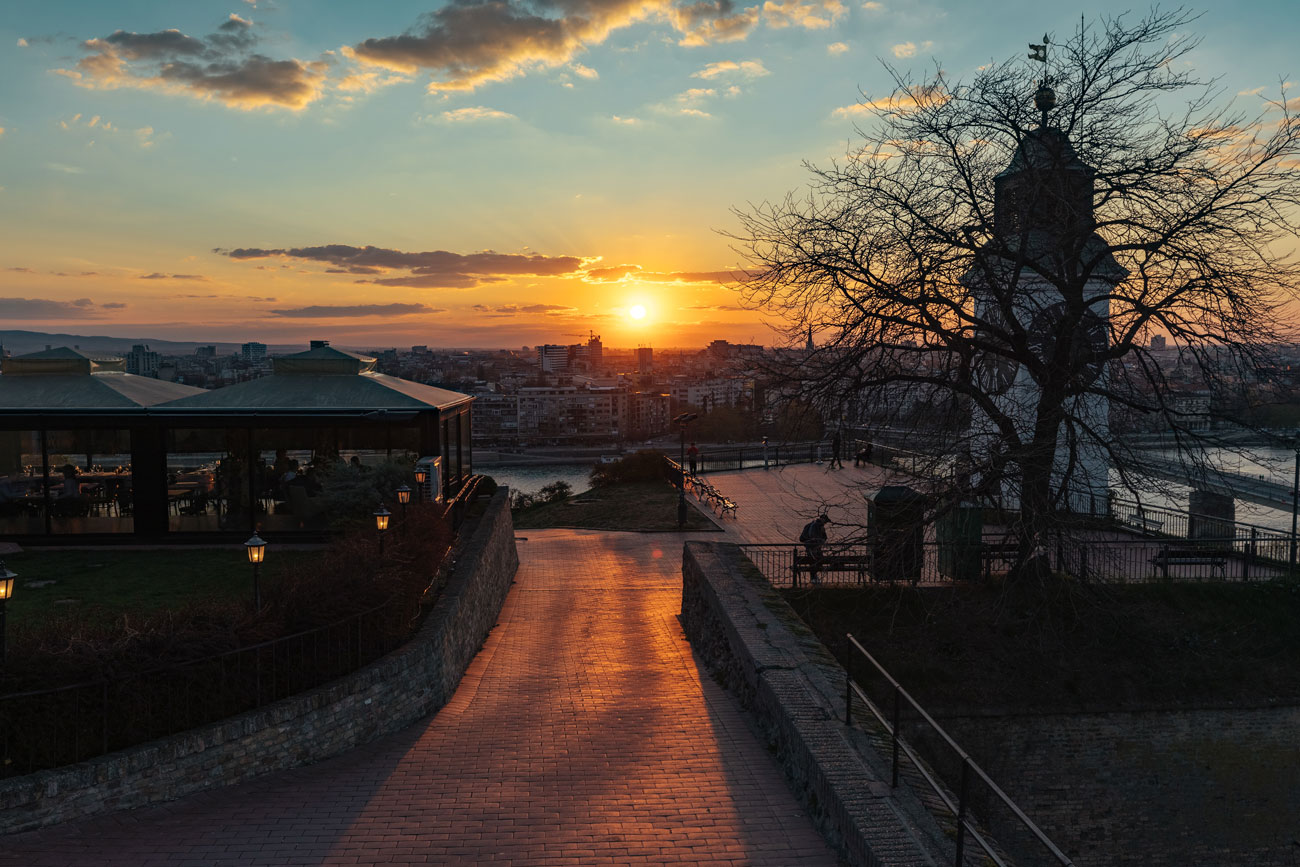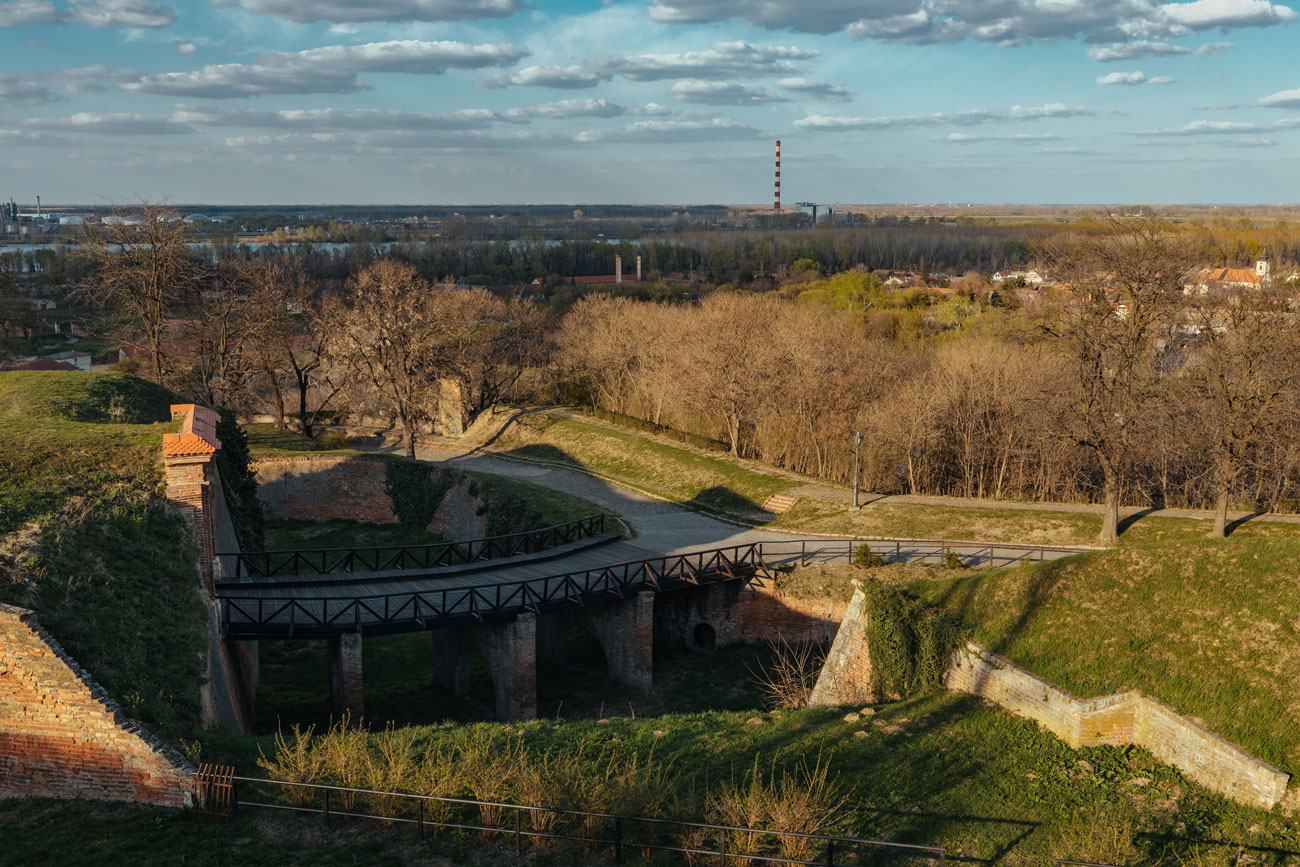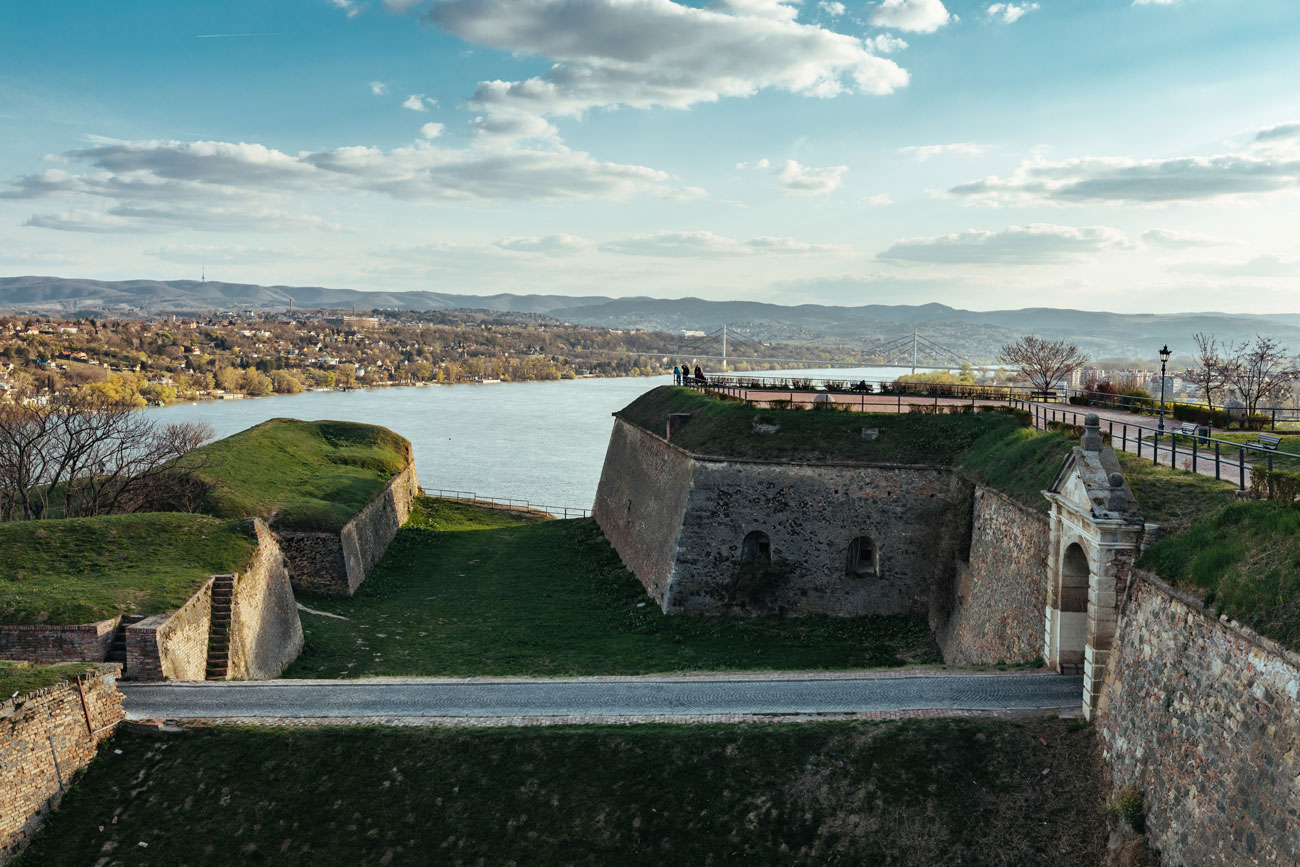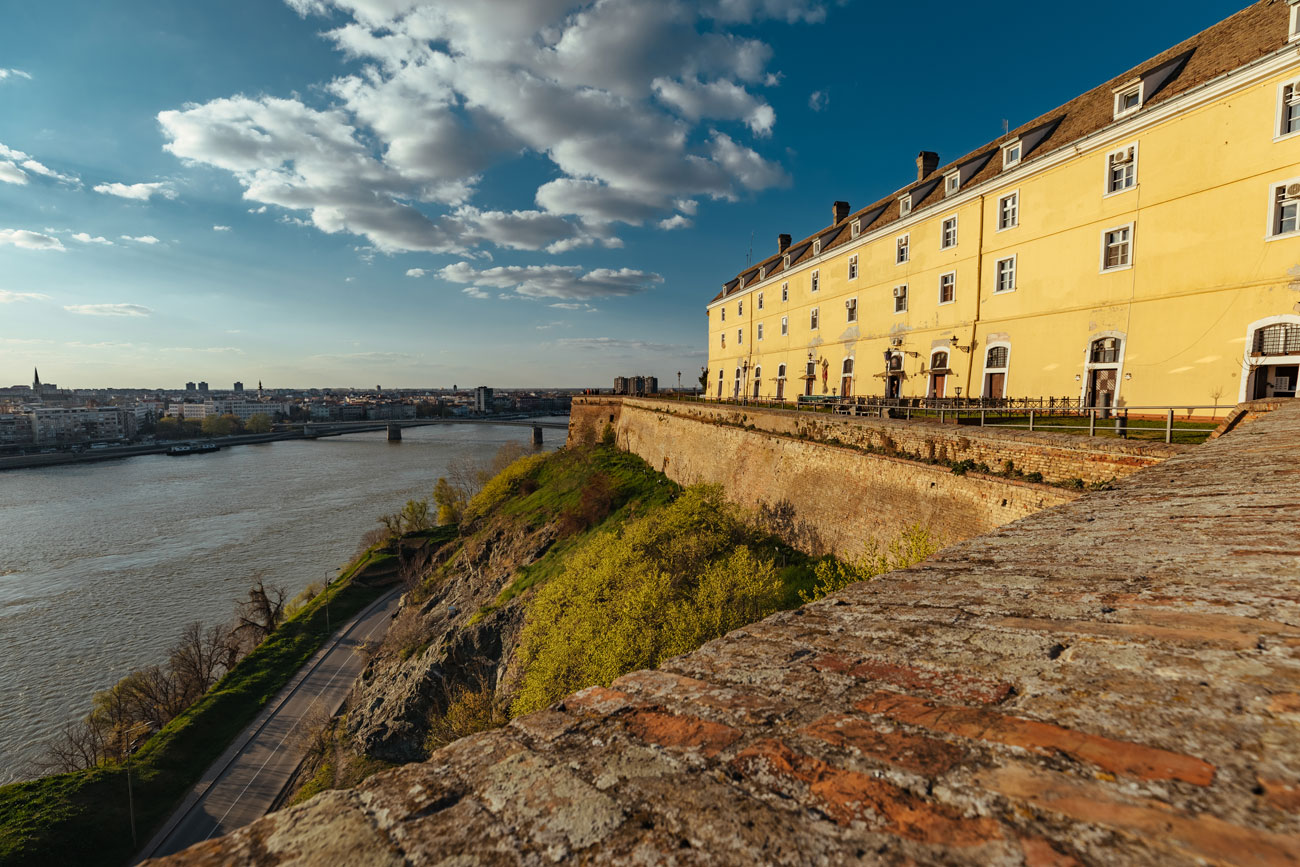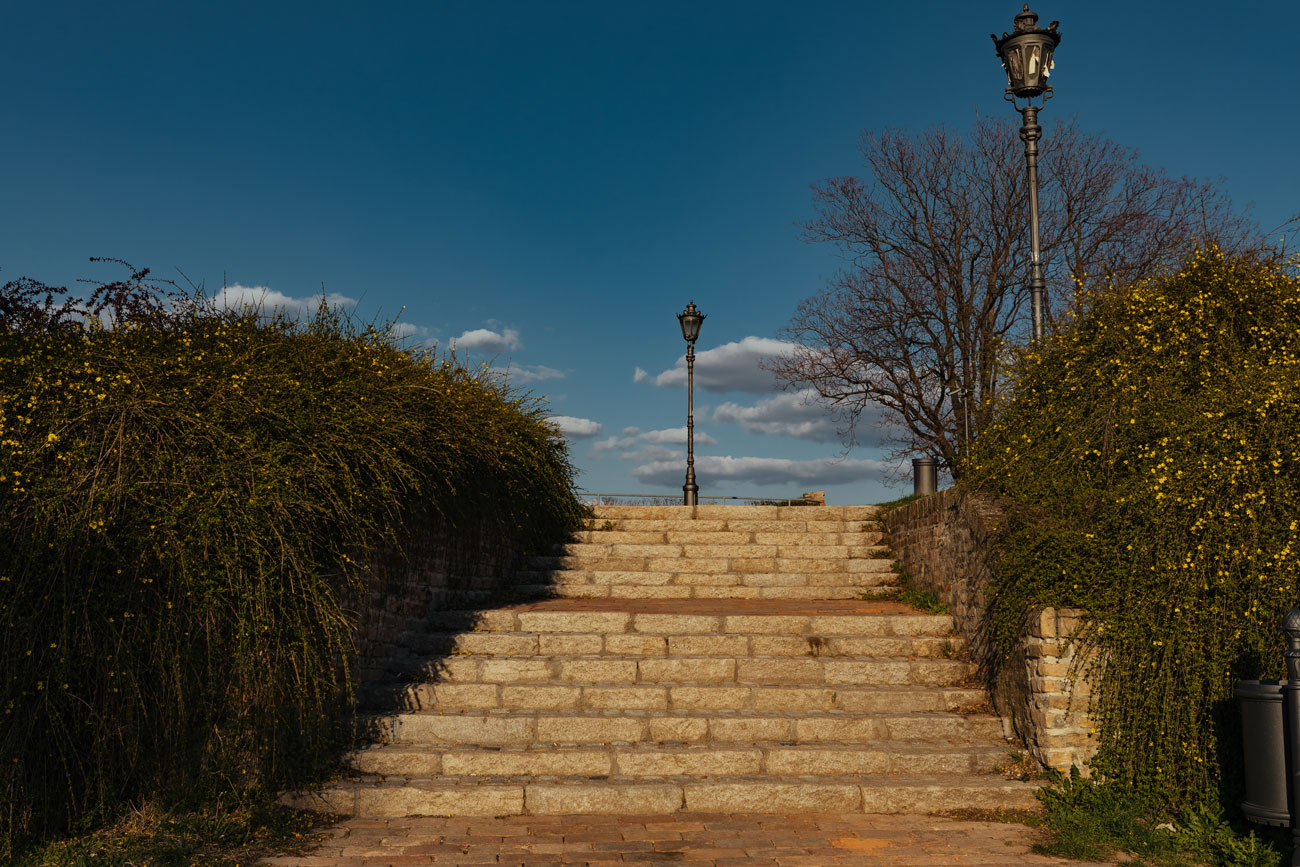They were drawn by the powerful Rock, which had changed the course of the mighty river. In comparison with other types of Men, they had larger brains and felt that the Rock was a newcomer. That it had magic powers. That it wasn’t from this world. Still, they couldn’t imagine how far it really was.
There was no hunting, sleeping or eating that day. The Neanderthals were sitting and feeling how the Rock was trembling. That’s why they worshiped the guest from afar with their quivering voices. In the dawn, they went away, but they returned each year when the time would come for them to sing a song to the Rock.
The first Europe was created around the Rock and the Vincha culture spread its knowledge of metal processing, writing and melioration. The Illyrians and Pannonians defended it while fighting for freedom. St. Andronicus, one of the Seventy Apostles, prayed on it by singing and so did Slavic scholar St. Methodius eight centuries later.
The fortress on the magic Rock spread out wide. Empires came and went, trying to take control of the sacred area using force. The tunnels underneath it were home to ancient animals, stolen treasures, secret libraries and a thousand cats.
And then, the tension defused. There was Music in the fortress again.
And the Rock awoke. Its power of love created a balance with the people that used to sing to it.
There were hundreds of thousands of them.
Magic Rock – Petrovaradin
In the everlasting conflict between the land and the sea, one battle was won by the land hundreds of years ago. Following several centuries of tireless splashing of the solitary island of Fruška gora, the Danube started taking the Pannonian Sea into some other sea. A vast plain replaced sea waves and the proud rock became a symbol of victory.
Perhaps the magic rock got its power from the energy of the ground, which is so strong at this location that it was able to conquer the powerful sea. Perhaps it receives its supernatural power from the brightest Sirius, whose divine powers are worshipped by the mysterious African Dogon tribe. Perhaps both theories hold water. Whatever the case may be, the rock has given strength and longevity to everything that was started on it. It has connected legends and nations, beliefs and mysteries, the land and the stars, young people and ancient tribes. It has become the perfect place for a long-lasting festival of love, music, positive energy, creativity, the perfect place for gathering people from all over the world who wish to do good deeds, who spread good vibes and who inspire and motivate others… The perfect place for EXIT.
After centuries of battles and wars, various civilizations and empires, the rock has pulled off another victory using its powerful magic by becoming a place that gathers, instead of a place that is conquered.
Legends about Petrovaradin
Tunnel under the Danube
The most famous legend related to Petrovaradin is the one about a secret passage under the Danube riverbed, which connects the fortress and the left bank of the Danube. The entrance to the tunnel is allegedly behind the altar of the Church of St. George, while the exit was behind the altar of the Church of Jon Nepomuk, which was located on the bridgehead. Legend has it that the last people to walk through the tunnel were an Austrian-Hungarian soldier and his fiancée in 1913.
Legend about cats
In the late XVII century, when the construction of the fortress began, the builders used to place live cats into the foundations of new fortifications. It was believed that cats had nine lives and by sacrificing them the construction would achieve longevity. This cat-related cult is confirmed by a stone relief of a cat’s head, which was found in the wall of the St. Innocent’s rampart and which is now kept at the City Museum of Novi Sad. It is presumed that the relief used to decorate the façade of a mediaeval church belonging to a Cistercian monastery from XIII century. The legend is further confirmed by the fact that the workers employed during the reconstruction works following World War II found mummified remains of cats, which turned to dust and ash when touched. Today, many centuries, wars and battles later, Petrovaradin Fortress is conquered only by numerous tourists, artists and musicians from all over the world, while the descendants of former pets of Cistercian monks greet and welcome them, while at the same time reminding them of the fortress’ turbulent past.
Construction of the fortress
Very difficult condition for the construction of Petrovaradin Fortress resulted in deaths of many workers. According to some sources, during the most intensive works, between 40 and 70 people were dying each day. The labour force was brought from all parts of the Habsburg Monarchy, which is why the fortress is also known as the “Foreigners’ Graveyard”. Among locals, there used to be a curse, “O, hero, I hope your soul builds Varadin”.
On the origin of the name
Among the stories related to the origin of the name Petrovaradin, the most famous version suggests that it was a combination of several words from different languages. “Petra“ means “rock” in Latin, “vár“ means “fortress” in Hungarian, while “din” means “faith” in Turkish. Loosely translated, Petrovaradin would mean “a town on the rock, solid as faith”.
Some legends mention a fisherman called Petar, who accidentally found great richness in jewels and gold coins. Believing that God had helped him, he built a church and a fortress on that location and they were named after him.
One of the oldest legends suggests that Petrovaradin was established by Peter the Hermit, organiser of the First Crusade at the end of XI century. On his voyage to the Middle East, he left a number of crusaders behind him and they built a fortress, which was named after him.
Due to its strategic position, Petrovaradin Fortress was named the “Gibraltar on the Danube” at the end of XVIII century, although it is also mentioned as the “Gibraltar of Hungary” and “Gibraltar of the Pannonian Plain”.
Dragon
One of the most famous legends concerns a dragon, i.e. a large snake living under the fortress, who would drown all those who dared to walk along the dark corridors. This legend is supported by a traditional poem “The Dragon of Petrovaradin”. It talks about a soldier who was late to report to his military barrack at the fortress. He was imprisoned in the underground part of the fortress, where the large snake strangled him. This legend has the most versions and there are many other stories similar to it.
Some have even named this beast “Peti” (after Nessie, the Loch Ness monster in Scotland). It was said the beast slept in the ice-breaker of the former rail-bridge and that it came out at night looking for food. Older tour guides mentioned a story according to which, in the time of the Kingdom of Yugoslavia, an officer killed a soldier following an argument. Since they were both Montenegrin, in order to prevent a blood feud, the family of the victim was told that the killer had been imprisoned under the fortress and that he had been killed by the beast while trying to escape.
There was also a story about a soldier who wanted to show the underground part to his girlfriend, but they never returned from their exploration. One version mentions a soldier who was imprisoned in the underground part because he had been drunk. Horrible screams could be heard from the casemate the first night and the guards were too afraid to enter the room until the morning, when they found the soldier’s body mutilated and his eyeballs sucked out.
This legend was revived last time during the NATO bombing of FR Yugoslavia in 1999. According to this version, the bombing disturbed the beast. The pollution caused by the bombing of the nearby oil refinery forced the beast to look for other sources of food. One fisherman said that his boat had capsized after receiving a strong blow. Terrified, he started swimming towards the riverbank. When he looked back, he saw something tearing his boat into pieces in rage. Another fisherman claims that he was running away, with his engine running, from the chasing beast and that he even hit it with a paddle at one point. Also, one more fisherman said that he had fired a gun at the beast that merely squirmed and disappeared under the water. During the bombing, many people claimed to have seen a frog-like head protruding from the river. Two fishermen insisted they had caught it in the net. It had the body of a lizard, the head of a pig and webbed feet. Being afraid, they cut the net and ran away. They believed it had been the beast’s offspring.
It is from stories that we learn about the origin of this beast. Outraged because they had lost the fortress, the Turks decided to take revenge by sneaking close to the fortress and throwing offspring of large snakes underneath it. Feeding on anything they could find, the snakes became huge. According to another story, Empress Maria Theresa used to collect various exotic animals and keep them in the fortress’ casemates. Her collection featured animals that were freaks of nature: a three-legged goat, a one-eyed wolf, large snakes and lizards, various freakish fish and amphibians. Once, after the Danube spilled over, the water got to the lower levels of the corridors at the fortress, where the menagerie was. Screams of dying animals could be heard, but some of them managed to get to the Danube.
After World War II, when the fortress was handed to civil authorities and faculties moved in, students used the secluded corners of the fortress for studying. One of them saw traces of a snake in the grass and organised a chase with his colleague. They returned empty-handed.
Missing in the underground
In the sixties of XX century, a group of young men got lost in the underground corridors of the fortress. A soldier heard their cry for help and went after them, but he too got lost. They tried to find a way out for days and ate roots to survive. In despair, they even tried to dig a way out with a bayonet. Eventually, they found an exit, which was not so far from them.
Fisherman’s daughter
Before the mediaeval Petrovaradin Fortress was built, on the banks of the Danube lived a poor fisherman, called Petar, with his wife. They were childless and their prayers to God remained unanswered. Once day, Devil appeared in a human form before Petar and offered him great richness in return for “what he had, but didn’t know he had”. The fisherman, who had nothing, accepted the deal and became rich overnight. Soon, he found out his wife was pregnant. Thinking how to keep his unborn child, Petar built a fortress and a church within it, for Devil could not step on the holy ground. His daughter was born in the church and never stepped out of it for eighteen years. One day, she heard a man’s voice calling her. She peeped outside the church and saw a gorgeous man and fell in love with him immediately. However, it was Devil, who had come to collect what was rightfully his. At the moment when he tried to grab her arm, the earth opened up and swallowed the girl, while the church collapsed and closed the crack in the ground. Legend has it that the girl is still wondering along the underground corridors, looking for the unknown man.
Cultural institutions and sites
City Museum of Novi Sad
The Museum of Novi Sad is located on several locations. The main building is at Petrovaradin Fortress and it hosts two permanent exhibitions: “The Fortress in the Past“ and “Novi Sad from 18thto 20thCentury“. Also, there are City Museums in Dunavska Street in Novi Sad, Sremski Karlovci and Sremska Kamenica, where visitors can learn many facts about Novi Sad and its history, culture, religion, ways of living, multi-confessional society and see some of 50,000 artefacts. It is possible to walk through the corridors and subterranean military galleries, which are reorganized for special tours, but such tours have to be guided.
Clock Tower
The Clock Tower is in the Upper Town of the fortress. On this site, there used to be an older tower, which was demolished in 18thcentury. The radius of the clock is more than two metres long, the four clock faces are directed toward all four general directions, the numbers are in Roman numerals and the main characteristics of this clock is that the longer hand tells the hours and the shorter one tells the minutes. This type of a clock needs to be wound up daily.
On the top of the tower, there are a vane and a compass. Near the clock tower, there is the so-called long barrack, i.e. a two-storey building from the second half of 18th century. At this building, in 1926 was the Aviation NCO school of the Kingdom of Serbs, Croats and Slovenes. The most renowned pupil was Franjo Kluz, aviation pioneer from World War II. One of the most prominent buildings of the Upper Town is the Leopold’s gate, with baroque foreground and suspension bridge, but also with a coat of arms and a motto of the Habsburg monarchy “With United Forces“.
Underground military galleries
Subterranean Military Galleries is a four-story communication and defensive system, ten miles long. This complicated system was built in 1783 and it represented a real tourist attraction. Tour guides show this web of corridors and rooms, crenels and mining systems. A peculiarity of Petrovaradin is that it has never been conquered. Therefore, during 19thcentury, here was a treasure chamber with gold and silver of the Habsburg Monarchy.
The fortress was built during the reign of the Habsburg dynasty and Habsburg-Lorraine with rulers: Leopold I, Carlo VI, Maria Theresa and Joseph II. Maria Theresa (ruled from 1740 to 1780) never visited Petrovaradin fortress, but it is well-known that she granted Petrovaradin (for the amount of 80,000 forints) the status of a free royal city on February 1st, 1748. From that time on, the town has been called Novi Sad, Neoplanta, Újvidék or Neusatz. Her son, Joseph II (ruled from 1780 to 1790), visited Petrovaradin Fortress four times.
Atelier 61
Atelier 61 was founded in 1961 as a workshop for manufacture of artistic tapestries of large formats and it is one of unique and rare institutions of this type in the world. It was founded by Boško Petrović (1922-1982). The role and the main objective of Atelier 61 is the preservation of tradition of manufacture of items made of fabric. In the early sixties, it already started producing large format tapestries according to the drafts of well-known Yugoslav artists Stojan Ćelić, Lazar Vujaklija, Mladen Srbinović, Milan Konjović, Ankica Oprešnik, etc.
The first exhibitions in the country and abroad (Scandinavia, Latin America, USA, Europe) of tapestries made in Atelier 61 were welcomed with high recognitions that introduced this workshop to the map of cultural institutions of great value. During its history that is half a century long, more than 800 tapestries have been made in Atelier 61 in co-operation with close to 200 artists. The first weavers were women who learnt the craft from their mothers and grandmothers. Currently, they are the weavers who learnt the craft at “Bogdan Šuput“ secondary school of arts. The institution also includes the Gallery of Tapestries “Boško Petrović“, which was established in 1999. In addition to the exhibition of tapestries from the “Atelier 61 Collection”, the Gallery also hosts musical and literary evenings. The Gallery of Boško Petrović is located at the Leopold’s Gunpowder Magazine, beneath St. Leopold’s Bastion.
Belgrade Gate
BELGRADE GATE (Beogradska kapija) was built in 1753 between two bastions, the one of Saint Ernest and another of Saint Ignatius. It is 20 meters high and has two lanes and two pedestrian passages. Next to the gate, there used to be a prison, formally called “Central Penal Institution of the Military Court of Slavonian General Command“.
In that prison, officers, soldiers and civilians used to serve their sentences. The best known prisoners were the Admiral of Peter the Great, Matija Zmajević (1680- 1735), Bulgarian writer Ljuben Karavelov (1834-1879), socialist and a national tribune Vasa Pelagić (1833-1899), poet Antun Gustav Matoš (1873-1914), politician Jaša Tomić (1856-1922) and Josip Broz Tito (1892-1980).
Roman-Catholic Church of St. George
Roman-Catholic Church of St. George with a convent was built in the baroque style between 1701 and 1714, and a residency of the convent in 1734. On the façade of the church is a statue of the founder of the Society of Jesus, Saint Ignatius. In the basement, there is a crypt where the representatives of the nobles were buried after they got killed in battles against the Turks from 1696 to 1716. The oldest epitaph on the tombstone is inside the church, and is dedicated to Baron Heinrich Nehem, a general and commander who served at Petrovaradin Fortress, where he died in 1713. That epitaph says that the God bestowed an eternal home on him for his virtues. In the Roman-Catholic church of the St. George there are also tablets which say that Emperor Franc Joseph (1830-1916) visited the fortress and so did regent Aleksandar Karađorđević (1888-1934) in 1919.
Novi Sad Astronomy Observatory with Planetarium
Petrovaradin Fortress is home to the Novi Sad Astronomy Observatory with Planetarium, which is unique in Serbia, together with the Belgrade Planetarium. The scientific and educational activities of the Planetarium are managed by the Astronomic Society Novi Sad, which organises for visitors, especially pupils and students, audio-visual lectures on astronomy and similar scientific disciplines.
The Planetarium is open to public visits on Thursdays from 08.00 p.m. and the entrance is free of charge. You can find all information and check the schedule of public visits directly at the web site of the Astronomic Society Novi Sad http://www.adnos.org/
EXIT Festival
The two-time winner of the “Best Major European Festival” award, EXIT is held each year at the 18th century colossal Petrovaradin Fortress in the city of Novi Sad in Serbia. EXIT started as a student movement whose massive protests brought down the oppressive regime in Serbia. EXIT became the first mass event to gather all the people in Balkans after a long decade of divisions. Celebrated as a place where hedonism meets activism, it is the social relevance of EXIT that has made it unique and globally recognized, hosting world music stars in nearly two decades since its inception in 2000.
So far, EXIT hosted a worldwide audience of over 2.5 million visitors from 60 different countries. During the four days of life-changing experience, EXIT offers programme for music lovers of all genres from rock, pop, hardcore punk, death metal, to techno, reggae, disco, indie, hip-hop, grime, dubstep and more, with a diverse mix of over 1000 artists performing on more than 40 stages and zones connected by cobbled streets, ramparts and tunnels. It’s that special moment when the suns rays shine over the fortress walls and your favourite tune is belting through the soundsystem and into your soul, that will make this festival your favouite one. One trip to Novi Sad, the ‘Gibraltar on the Danube’ as they call it, and you’ll fall for its full-on charms too.
More info: exitfest.org
Tamburica Fest
International tamburitza festival “Tamburica Fest” is held at Petrovaradin fortress in Novi Sad as a 5 day festival with unique concept and cultural mission to promote tamburitza music and present tambouritza as instrument, also to cherish tradition, cooperation and artist friendship on internation level.
Every year orchestras from Serbia and abroad are competing in competition part of festival while in non competitie selection there will be apperances of well known artists accompanying by tamburitza orchestras.
Introduction festival day by tradition is held in main city square “Trg slobode” in Novi Sad and starts off with special coach parade throughout city streets followed with performances of etno troupes, tamburitza bands.
Second and third festival day are held on Petrovaradin fortres where tamburitza bands will present skills and knowledge in playing of tradicional, authoring song, new compozitions also there will be perfoms of well known interpreters.
More info: tamburicafest.com
Artists’ Circle
Artists’ Circle is the largest informal art colony in the world, since it has been gathering for more than fifty years now over 200 artists, mostly painters. The visitors to Petrovaradin Fortress are allowed (provide they get the artists’ permission) to enter ateliers, buy paintings or have a chat with artists, many of whom have life stories that include almost all continents. We should also mention the ITD Gallery and the Institute for Design Transfusion, where visitors can buy authentic souvenirs from Novi Sad and Petrovaradin Fortress.
Galerija Radošević
Creative studio „Galerija ITD Radošević“ is a surreal place that settles down and locks itself in an energy hatch where some new ideas, truths and directions can be grasped, in some broader terms.
More info: design-radosevic.com
History
The rock of Petrovaradin and its vicinity – the space occupied by Petrovaradin Fortress – had perfect conditions to be home to the earliest human settlements. The archaeological research conducted in 21stcentury showed that the plateau featured a series of twelve settlement, most of them having been fortified. Archaeologists are convinced that there are more prehistoric and more recent settlements still not discovered.
When they found stone tools from the Old Stone Age (70.000 – 40.000 BC), they established that the first settlers on the rock of Petrovaradin were the Neanderthals. The stone tools made of white, yellow, green and black stone, quartz, red jasper and other material are similar in shape and processing method to other mediaeval findings from that period.
After the Neanderthals, the rock of Petrovaradin was uninhabited for quite a while, or we still haven’t found any proof of later settlements. The first and the oldest settlement was established by members of the Vinča culture, who were a mix of domiciled members of the Starčevo culture and colonists who had come from Asia Minor at the end of the sixth millennium BC. So, there was a settlement on the rock of Petrovaradin in the New Stone Age, between 4500 and 3200 BC.
The first fortification on the rock of Petrovaradin was built during the Copper Age (3200 – 2000 BC). Due to constant migration waves from the southeast, large settlements started turning into field fortresses. Remains of one such powerful rampart from that period have been found on the lowest terrace of the rock of Petrovaradin. Several locations and a settlement belonging to the Vučedol culture from that period have been discovered, which suggests they covered a large area. During the turbulent Bronze Age (2000–950 BC), settlements belonging to the Vinkovci and Belegiš cultures were the most prominent. It was on the foundations of these settlements that several settlements belonging to the Bosut culture were built in the Old Iron Age (950–250 BC). During the New Iron Age (III-I century BC), the local Illyrian and Pannonian settlers witnessed the migration of the Celts, who started appearing on the territory of the Pannonian Plane. The Scordisci, a Celtic tribe mixed with the Illyrians, settled in the centre of the Danube region and erected a fortification on the rock of Petrovaradin, which would later serve as an economic centre.
At the beginning of I century AD, the territory of Srem fell under the militarily expansive Roman power and the rock of Petrovaradin became part of the fortified border – Limes. Just like three other fortresses from the Creative History Balkans Tour (Shkodër, Budva and Banja Luka), this area was the venue of the Illyrian-Pannonian liberation uprising between 6 and 9 AD (Baton’s Uprising, Bellum Batonianum or the Great Illyrian Uprising) — an event that shook the foundations of the Roman Empire and was smothered in blood by the imperial military commander Germanicus.
Srem is an area of great international importance. In the vicinity of Petrovaradin there is the town of Sremska Mitrovica, ancient Sirmium, one of the capitals of the Roman Empire and the seat of the diocese during early Christianity in I century – since the time the bishop was a kinsman of St. Paul – St Andronicus, one of the seventeen apostles.
Archaeological excavations also revealed remains of ancient houses, a rampart and a large quantity of movable material, such as segments of Roman helmets and ceramics with relief decorations. Also, remains of a settlement and necropolis were discovered in the close proximity. The research has confirmed the existence of the Roman castle Cusum (Castellum Cusum).
It has been established that all facilities were destroyed in a great fire at the end of IV century. Until VI century, the area was part of the East Roman Empire. In the turbulent centuries marked by great migrations of people, the area of Srem was under the attacks of the Huns, the Gepids, the Slavs and the Avars and it fell under the power of the Francistian, Bulgarian, Byzantine, Serbian and Hungarian states. The Slavs, and the Serbs in particular, were in majority since the early Middle Ages, while St. Methodius, brother of St Cyril, was the Archbishop of Sirmium in IX century, with the seat in the nearby Mitrovica.
Hungarian kings, aiming to strengthen their rule and spread Roman-Catholic Christianity onto newly conquered territories gave the monastic orders from the west estates where churches and monasteries were built. For instance, in 1237 King Bela gave the monastic order of Cistercians estates that included the area of present-day Petrovaradin. The monastery called Belafons was built on this estate.
The development of fortresses was temporarily stopped in the Middle Ages. The feudal system insisted only on building small fortifications, stand-alone towers and castles for landowners. It was only with the emergence of the crusades that the theory and practice of military architecture was starting to develop, which led to a greater number of fortresses being built more quickly. Also, the arrival of the Mongolians to Europe in the mid-XIII played an important role. After their withdrawal from Europe, numerous fortresses were built on the territory of Hungary and among them was Belafons, on the rock of Petrovaradin. It was built between 1243 and 1254 and the Cistercians erected a church dedicated to the Blessed Virgin Mary. The fortress was named after Petar Terefi, head of the Csanad parish and the settlement of the same name from across the Danube, Petrovaradin (Petar’s fortress). In XV century, Petrovaradin became one of the wealthiest abbeys in south Hungary. King Matthias Corvinus gave Petrovarad to Cardinal Rodrigo Borja, who would never visit it, which is why both the abbey and the fortress started declining.
The military and strategic importance of Petrovaradin grew as the Ottoman Empire was advancing deeper into Europe. At the beginning of XV century, funds were allocated for the church renovation, solidifying the outer ramparts and the main tower. The importance of Petrovaradin is confirmed by the fact that, apart from King Bela IV, Charles Robert, Andrew II, Sigismund of Luxemburg, Matthias Corvinus and Luis I the Great all stayed here. After the fall of Bosnia under the Ottoman Empire in 1463, King Matthias Corvinus signed an agreement on alliance with the Republic of Venice in Petrovaradin.
Following the fall of Belgrade in 1521, Turkish assaults on the territory of Srem became more frequent. Sultan Suleiman I started his campaign against Hungary in 1526 and Great Vizier Ibrahim Pasha led the siege of Petrovaradin, which was defended by a small number of soldiers. After a two-week siege, the surviving defenders who had retreated to a tower were once again called to surrender and were released eventually.
After the fall under the Ottoman Empire, Petrovaradin was still occupied by soldiers. The earliest news about the structure of military personnel came in 1529, when it was written that the fortress was occupied by 200 members of cavalry, 300 Azabs, 200 members of the Martolos, 300 Janissaries and 250 gunmen. Some of the most interesting descriptions of Petrovaradin under the Ottoman rule come from numerous exploreres who sailed on the Danube in XVI century. In 1533, Derschwam wrote that the town was very white and looked solid. A small, but nice town surrounded by walls and towers is mentioned by Pigafetta. Rim wrote that he had been lucky enough to tour the fortress and that it was occupied exclusively by the Turks, while the old Christian church in it had been converted into a mosque and partly into a warehouse for storing barley and flour. Gerlach mentioned that there were few guns in the fortress and that some of them had the herald of Emperor Zsigmond and that apart from “miserable shacks” where solders lived there was nothing worth seeing. Lubenau describes Petrovaradin as a nice fortress, masterfully built on a rocky slope, of circular shape with nice towers and ramparts, surrounded by two walls between which there were many wooden houses and the most prominent feature – a church in the centre. Below the hill, where the fortress still lies, there was a settlement with another nice Christian church, on whose door there was an inscription – “Maria virgo mater Dei miserere mei“. Next to the fortress, there were marvellous vineyards and some nice watermills on the Danube banks.
In the second half of XVI century, Petrovaradin received the status of “kasaba” (small town), so it had to feature other facilities typical of Islamic architecture. First and foremost, a “han”, i.e. a caravanserai, shops and possibly a hammam, as well as other institutions typical of the Muslim culture. Until mid-XVI century, there were 90 Serbian households and there are records of two Muslim mahalas with 128 households, 35 of them Christian. Among the Muslims, there were soap-makers, tailors who worked with leather, shoemakers, tanners, masons, tailors and weavers. In mid-XVII century, Ottoman explorer Çelebi mentioned three madrasas for those studying the Quran, for primary schools, while the number of khanqahs, hammams, shops and caravanserais was not listed. However, he mentioned there was a bedesten. From his account, we can learn that the locals were primarily dealing with trade and shipbuilding. Christians were mainly included in the work of a raft on the Danube or during a war they would operate a pontoon bridge and were rewarded for it by being exempt from some paying certain taxes. Agricultural production also brought significant income. Apart from cereals and vineyards, there is a mention of various vegetables, such as lentil, cabbage, onions and garlic, as well as some fruit. The Ottoman rule lasted until the Great Turkish War(1683–1699), which ended with the Treaty of Karlowitz and Petrovaradin became part of the Habsburg Monarchy.
When Petrovaradin came under Austrian rule in 1687, the rock of Petrovaradin still featured an old mediaeval fortress. The oldest preserved plan from 1688 suggests that it consisted of an outer and inner segment. The outer wall was fortified with two half-towers and support pillars on the outside and there was a deep trench around it. From a keep and its outer gate on the south side, there was a road towards the gate to the inner part of the town, which was in the shape of a rectangular. The inner part of the town boasted a large church with two towers and they had cisterns for water on both sides, while the northwest corner was home to the commander’s palace. On the opposite bank, there was a smaller fortification, surrounded with a moat, on whose west side there was an artillery tower with five openings for guns. The fact that the fortress was completely neglected is confirmed by the fact that wood was used to fill all the cracks in the ramparts.
Austrian military engineers decided to completely demolish the old mediaeval fortress and build a modern fortification. Officially, the construction works on the new fortress started when the foundation stone was laid on 18thOctober 1692. The construction was slow. Apart from the shortage of money and construction material, the area around Petrovaradin was still scarcely populated, even after the arrival of the Austrians and there were few craftsmen with construction skills. After the works were completed in 1699, Petrovaradin welcomed many craftsmen from German and Croatian parts, who established Švapsko selo (“German village”), while on the other side Ludwig and Rock’s dol were established. The people living in the lower part of the fortress were mainly of German or other foreign origin and they were primarily focused on winegrowing and agriculture. Protestants, the Orthodox, the Jewish and Muslims were not allowed to have a house, nor basic citizen’s rights in Petrovaradin, so they settled on the other bank of the Danube and established a settlement that was originally called Ratzen Stadt (Serbian City), because most of the people were Serbs. That settlement later became Novi Sad.
The construction works on the fortress were interrupted for a brief period due to the new war between Austria and the Ottoman Empire in 1716–1718. The hostile actions between the two empires began with minor conflicts in the spring of 1716 along the Sava and Danube rivers, while the first battle between the great armies took place near Petrovaradin on 5thAugust. The Ottoman Empire army of around 120,000 soldiers was led by the Great Vizier Silahdar Damat Ali Pasha, while the Austrian army of around 80,000 was led by Prince Eugene of Savoy. Petrovaradin was already blocked from the Srem side on 3rdAugust, while the garrison in the fortress only kept contact with the rest of the Austrian army over two pontoon bridges on the Danube. During the night between 4thand 5thAugust, the whole Austrian army crossed the Danube and attacked the unsuspected Ottoman army at 7 o’clock in the morning. The battle lasted for several hours and ended in the defeat of the Ottoman army and the Great Vizier’s death. The Austrian army confiscated a large quantity of war material and food and immediately started their march towards Timisoara, which they occupied a few months later. The following year, the Austrian army occupied Belgrade as well, which created favourable conditions for peace talks that were concluded in Požarevacin 1718.
The construction of the fortress took place in two phases. The first phase of construction occurred from 1692 to 1728. That was when the Upper Fortress, the Lower (Water) Town, the hornwork, the bridgehead on the left bank of the Danube and the fortification on the Great War Island were built. To the south of the hornwork, they started building a kronverk, but gave up after the earthquake in 1722, which completely demolished everything they had done previously. In one report from 1735, it is mentioned that the walls of the Upper Fortress were not completely finished, the east side of the hornwork was completely open, while the earthen ramparts of the Lower Fortress were completely uncultivated and almost collapsed. The construction of the fortress was also influenced by the shift of the border of the two empires to the south, when the priority was given to the construction of the fortress in Belgrade.
The second phase in the construction of Petrovaradin Fortress didn’t start until mid-XVIII century and it finished in 1780. This period saw the completion of works on the construction of the Upper Fortress, the fortifications around the Water Town were put down and they built five instead of three bastion fronts. The existing bridgehead and the fortification of the island were completely destroyed and new fortifications were built in their place to serve the same purpose. Apart from the new facilities, the Petrovaradin Fortress complex also boasted numerous other additions (arsenals, gunpowder storages, military barracks, officers’ pavilions, warehouses, a new command centre, a military hospital, a pharmacy, a post office, bakeries…). Between wars, the garrison in Petrovaradin had around 2,500 soldiers, while during wars that number could rise to over 9,000. The largest number of soldier according to a census from the late XVIII century comprised members of infantry (8,134), cavalry (120), artillery (over 863), engineering unit (93), supply depots (89) and commanding officers (64). Petrovaradin Fortress has never served the purpose it was built for. Still, during the Hungarian revolution of 1848/49, the fortress garrison, consisting mainly of soldiers of Hungarian origin, joined the revolutionaries’ side. Petrovaradin Fortress was blocked from the Srem side until the end of the Hungarian revolution, but there were frequent assaults towards Sremski Karlovci, Sremska Kamenica and Rimski šančevi. In the middle of 1849, the arrival of the Austrian army under the command of Ban Josip Jelačić to Novi Sad provoked the bombing of the town from Petrovaradin Fortress and the bridgehead. In order to protect the pontoon bridges on the Danube, the garrison started a fire that almost destroyed Novi Sad. Following the unsuccessful revolution, the garrison in Petrovaradin surrendered (for the first time in history) to Austrian commander Lazar Mamula. In the decades that followed, Petrovaradin Fortress was mostly used as a large warehouse and a prison that many famous people ended up in. Đorđe Petrović, the leader of the First Serbian Uprising was imprisoned in Petrovaradin for a while after the uprising ended. Other renowned people include Vasa Pelagić, Antun Gustav Matoš, Jaša Tomić, Josip Broz, Ivo Andrić, Vladimir Jovanović, Matija Zmajević, Ljuben Karavelov, Sándor Rózsa…
The degradation of the Petrovaradin Fortress complex started at the end of XVIII and beginning of XIX century, when due to high waters of the Danube damaged and subsequently completely destroyed the fortification on the Great War Island. In the years immediately after World War I, Petrovaradin Fortress lost its bridgehead on the left bank of the Danube. In 1921, the bridgehead and the area around it came under the auspices of the city of Novi Sad, only to be demolished between 1922 and 1924, when the first permanent bridge for vehicles and pedestrians across the Danube, between Petrovaradin and Novi Sad, was built.
On the eve of World War II, in 1939 the roads towards Sremska Kamenica and Petrovaradin were widened and some gates of the fortress and outer segments of the fortification were removed. Historian Rudolf Schmidt noticed back then that the fortress was “being demolished more and more” and he provided testimonies of numerous smaller damages on the walls “due to obstinate actions of individuals”. According to him, Petrovaradin Fortress, apart from its historic and scientific importance, could also be the most remarkable sight of Novi Sad, that could boost “the tourist appeal, so is should be protected from every flaw.”
After World War II, Petrovaradin Fortress was put under state protection in 1948 and in 1951 most of it was given to civil authorities. The following year saw the establishment of the city’s department in charge of Petrovaradin Fortress, headed by architect Andrija Sečujski for the next ten years. The department submitted a proposal for reconstruction to the People’s Committee in 1957, but that’s when they lost tack of it. During this period, numerous ramparts were reconstructed and the facilities were adapted to serve cultural and educational institutions and some of them are still there (the City Museum of Novi Sad, the Academy of Arts, the planetarium, the observatory, Atelier 61, numerous ateliers of masters in fine- and applied arts.).
In 1962, the department was integrated into “Gradsko zelenino” (“Greenery”), which only led to stagnation and poorer quality of maintenance. After several decades of the management of civil authorities, despite all committees, documents related to urban planning and other issues, protection, utility organisations and public companies, architect Slobodan Jovanović found the fortress at the beginning of XXI century to be “a feeble patient suffering from all sorts of illnesses” and who needed a thorough rehabilitation, care and revitalisation. He noted that there had always been plans and programmes, ideas and visions, but they had never materialised. Artist Jovan Soldatović noticed a half a century ago that the fortress would “speak openly about us, our interference and knowledge how to use it and, as such, it will remain a permanent document testifying to our mentality, awareness or a yardstick we’ll use to measure our present-day culture.”
In XXI century, Petrovaradin Fortress became the centre of the largest open-air music and theatre festivals and it has been receiving a long-overdue detailed makeover in the years leading to its being elected the European Capital of Culture.
The structure of the fortress
The fortress as we know it today came to existence over a long period of time. It was being built for almost 88 years, with longer or shorter interruption. Many military engineers from the court in Vienna took part in its design and construction. When the construction was finally finished, the fortress was dubbed “the Gibraltar on the Danube” and was considered the strongest fortification in the Habsburg Monarchy and this part of Europe. Because it has been preserved to a great extent, Petrovaradin Fortress is a unique example of military architecture from the period when it was built. Almost all parts of basic ramparts (bastion fronts) have been preserved and so have a number of outer fortifications (counterguards, ravelins, caponiers, lunettes, envelopes…). Its countermine system (underground military galleries) is one of the most complex and best preserved example of this type of defence of fortresses. Furthermore, the fortress boasts all characteristics of fortifications found on plains, near water, in hills or mountains, adapted to suit the geomorphic characteristic of the space it was built on. What makes Petrovaradin Fortress stand out among numerous other fortresses and fortified towns in this part of Europe is how much it has been preserved. Many other fortifications built by the Habsburg Monarchy in XVIII century near the border with the Ottoman Empire (Karlovac, Gradiška, Brod, Osijek, Rača, Timisoara, Ada Kale…) have been either completely destroyed or only partially preserved.
References
• ~ Izvod iz analize stanja Petrovaradinske tvrđave, RO Urbanizam, Zavod za urbanizam Novi Sad, Novi Sad 1989.
• ~ Ratni dnevnik Eugena Savojskog: trista godina bitke kod Petrovaradina, Muzej grada Novog Sada, Novi Sad 2016.
• ~ Službeni list Grada Novog Sada, br. 02/1991
• Babić, Slobodanka. „Petrovaradin – Petrovaradinska tvrđava“, Umetnička topografija Novog Sada, Novi Sad 2014.
• Čanković Popović, Angelina. Petrovaradinska tvrđava, Novi Sad 2008.
• Engel, Franc Štefan. Opis Kraljevine Slavonije i Vojvodstva Srema, Novi Sad 2006.
• Gajić, Radenko. Petrovaradinska tvrđava – Gibraltar na Dunavu, Sremski Karlovci 2003.
• Gavanski, Đorđe. Petrovaradinska tvrđava, Novi Sad 1989.
• Jovanović, Slobodan. „Reč urednika“, DaNS, Društvo arhitekata Novog Sada, 44/2003.
• Jovanović, Slobodan. „Kruna nad gradom“, DaNS, Društvo arhitekata Novog Sada, 44/2003.
• Karavidić, Bojana. Zaboravljeni grad – Pograđe Petrovaradinske tvrđave, Petrovaradin 2005.
• Lukić, Miloš. Petrovaradin u prošlosti, Novi Sad 1992.
• Maksimović, Branko. Novi Sad danas i sutra, Novi Sad, 1937.
• Marković, Živko. Šetnja po Petrovaradinskoj tvrđavi, Novi Sad 1996.
• Marković, Živko. Novi Sad i Petrovaradin, Novi Sad 1989.
• Medović, Predrag. Novi Sad od neandertalaca to Turaka, Novi Sad 2014.
• Ozer Agneš. Petrovaradin – tvrđava na Dunavu, Novi Sad 2011.
• Radovanović, Slobodan S. Petrovaradinski vojni komunitet 1702–1849, Petrovaradin 2006.
• Sečujski, Andrija. Petrovaradin 800 godina „Gibraltara na Dunavu“, V jugoslovenske pozorišne igre, Sterijino pozorje, Novi Sad 1960.
• Soldatović Jovan. „Nakinđurena lepotica“, Dnevnik, 30. septembar 1962.
• Stanić, Stevan. Petrovaradin danas i sutra, Jugoslovenske pozorišne igre, Sterijino pozorje, Novi Sad 1960.
• Šeguljev, Nenad. „Petrovaradinska tvrđava – merilo stepena naše današnje kulture“, Godišnjak istorijskog arhiva grada Novog Sada, Novi Sad, 11/2017. Novi Sad 2017.
• Šmit, Rudolf R. „Petrovaradinska tvrđava“, Kulturno–privredni pregled Dunavske banovine, br. 5 i 6. za juni i juli 1938, Novi Sad 1939.
• Šmit, Rudolf. „Petrovaradinska tvrđava u vreme od 1697. do 1692“, Stari Novi Sad I, Novi Sad 1991.
• Šmit, Rudolf. „Varadin“, Vojvodina I, Novi Sad 1939.
• Terzić, Aleksandra. Perspektive razvoja kulturne rute Tvrđave na Dunavu u funkciji obogaćivanja turističke ponude Srbije, Beograd 2014.
• Vranić, Milan. Petrovaradin, Novi Sad 1963.
• Zirojević, Olga. Carigradski drum od Beograda do Budima u XVI i XVII veku, Novi Sad 1976.



